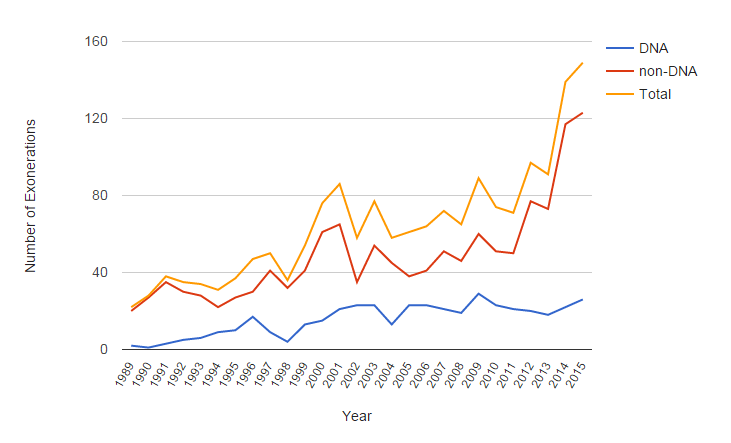Although there isn’t a consensus on the benefits of advances in technology, those falsely convicted of crimes and exonerated would be stark advocates of the forward progress. From the accessibility of DNA testing to the publicity of specific cases through film and social media, such as the Making a Murderer documentary, modernization has undoubtedly played a large role in the overturning of false convictions.
This relationship is evident with a recent report by the National Registry of Exonerations which found that 2015 was a record breaking year for exonerations in the United States at 149. The prior record was set in 2014 at 139 exonerations and since 2011, the annual number of exonerations has more than doubled. All told, there have been 1,733 known exonerations in the United States since 1989, and the weekly average of exonerations now sits at almost three per week. Furthermore, a study in Proceedings of the National Academy of Sciences estimated that 4.1% or about 1 in 25 of people on death row are sentenced to die for crimes that they did not commit.
For a country that prides itself on freedom and the protection of individual rights, it is unsettling to know that many mistakes have been made, especially since exonerated defendants spend an average of 14 years behind bars before having their sentences overturned. So how does this happen? And how many prior to 1989 were sentenced or killed for something they did not commit if the number of exonerated keeps growing each year? Based on data from the Innocence Project, there are a number of factors that lead to a wrongful conviction:
- Misidentification testimony was the leading cause of wrongful convictions, playing a role in over 70% of DNA exoneration cases. Moreover, studies have shown that people are less able to recognize faces of a different race than their own, which was present in 43% of these cases.
- Improper Forensic Science, such as bite mark comparisons, shoe print comparisons, or mishandled blood typing have played a role in 46% of convictions overturned by DNA testing.
- False Confessions, such as admitting to crime they did not commit, was a factor in 31% of cases and the leading factor in homicide cases at 61%.
- Informants who gave false statements contributed to 16% of wrongful convictions.
According to one Phoenix criminal lawyer, these types of mistakes are all too common. Take for example the case of Pete Williams in Georgia, who was indicated in a rape/kidnapping case because the victim was “120% sure” that he was the assailant. He was convicted by a jury but was proven innocent by DNA evidence after spending 21 years behind bars.
There is no doubt that determining the fault of criminal activity can be a tall task given certain circumstances, but hopefully with the rise of public interest and scientific assistance, the criminal justice system will be more willing to recognize that mistakes can and will be made.





No Comment